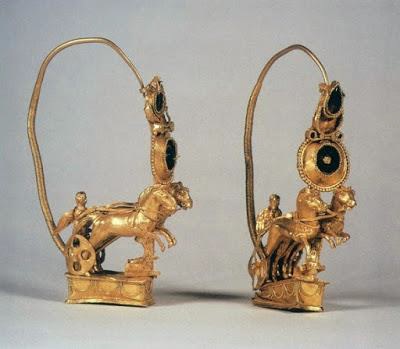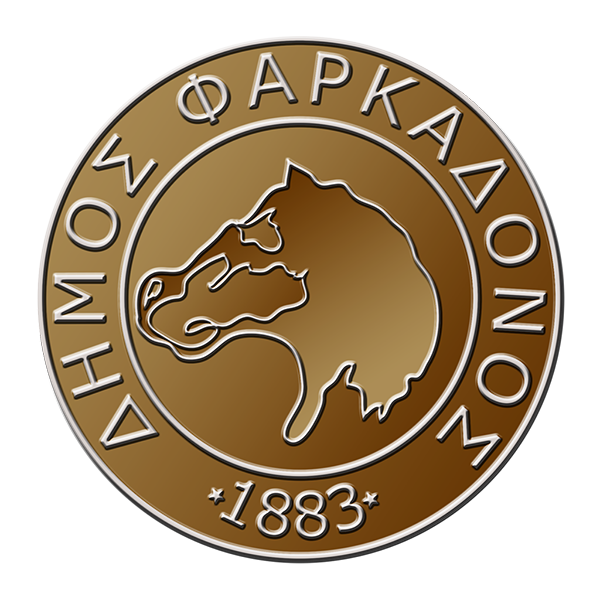The early history of Pelinna is lost in the mist of myths and uncertain local traditions of the region. According to the ancient philological information and the archaeological evidence, it was spread on the left bank of the Pinios river between Trikki and Farkadona. The settlement was built here, because deeper the plain was covered by many waters, because the springs that used to form the marsh of “VOULAS” gushed out from here, and this place was ideal for a Neolithic settlement.
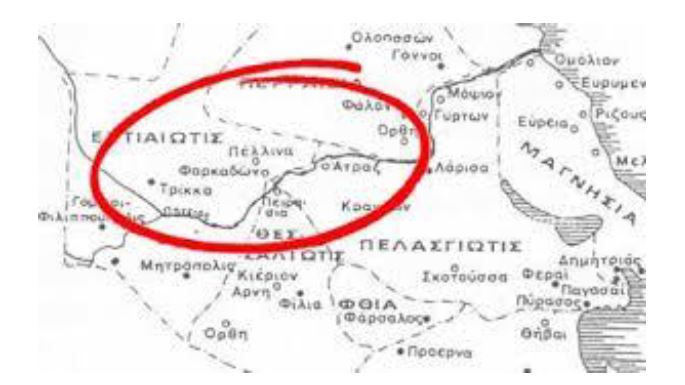
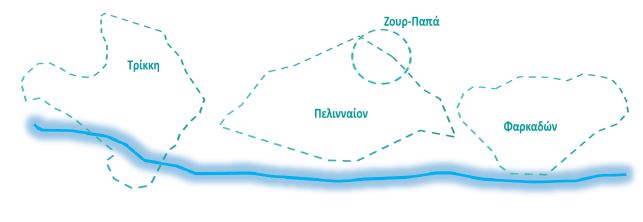
The strategic location of the city
Ancient Pelinna, as early as the time of the British traveler Leake, at the beginning of the 19th century, has been identified with the ruins on the rocky hill located in the massif of Mount Pelinnai, at the location “Paleogardiki”, 3 km northeast of the village of Petroporos. The position of Pelinna was extremely valuable because it controlled the road axis from Trikki to Larissa and especially the narrow passage between the confluence of the Litheos and the Pinios river, and the small mountains of the Provounos of the Khasias.
This passage had the form of a trap, if it is taken into account that in the area there was a huge marsh which occupied an area of thousands of acres, east of the village of Petroporos and north of the settlement of Farkadona and south of the community of Petrotos.
Founding of the city
According to mythology, Pellina was founded by Pellinos, son of Oichalios, from Oichalia. The first mention of Pelinna is made by Pindar in his 10th Pythian. He mentions it as the hometown of Hippocleus, son of Phricius, who won in the Pythias, in cross-country races in 498 BC.
PINDARUS, 10TH PYTHIONICUS
Happy is Lacedaemon, blessed is Thessaly; and in both generations from the same father reigns, from Heracles, the most worthy fighter of all. Does my praise go beyond measure? No; Pytho calls me and Pelinnaeus and the children of Aleus who lust after Hippocles to lead the male dance that will gloriously praise his victory.
Structural, architectural and fortification elements
Pelinna in the 6th and 5th centuries BC was limited to the top and the meridian slopes of the hill. In the middle of the 4th century BC the city expanded to the west and was fortified with a strong wall. The new wall was built according to the principles of the martial art of the late classical and early Hellenistic periods, according to the trapezoidal trapezoidal walling system with two faces of gray local limestone.
The horizontal corner stones, of local white-brown limestone from the quarries northwest of the sinkhole at “Zur Papa”, have the long sides horizontal and completely parallel, while the narrow sides are irregular and arranged to the left or right of an imaginary vertical line. The outer surface of the stones had rough carving work with a coarse needle, or was in many cases left entirely raw.
Their style varies from a polygonal masonry system to Byzantine reconstructions with mortar. On the NW side there is a large gate, two gates have been identified, while gates have been identified on the east and south sides of the walls. On the NW side there is a large gate, two gates have been identified, while gates have been identified on the east and south sides of the walls.
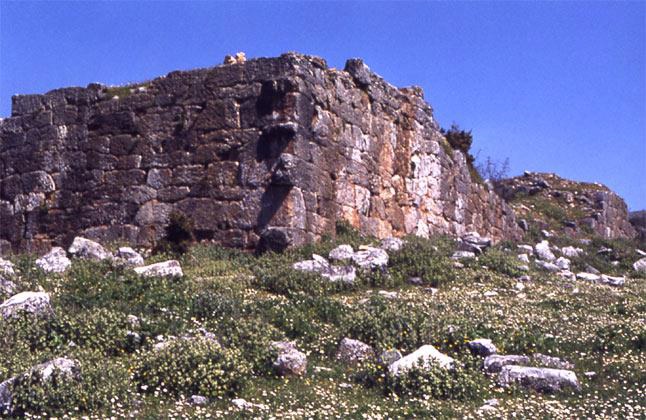
The towers built at the corners or vulnerable points of the wall, in the extension of the west side, are square, solid and larger than the rest and had internal ascending stairs.
The construction technique was the “entanglement”, with which the two sides of the wall were built with carved corner stones and the space in between was filled with small rough stones. On the wall there were ramparts and a corridor, the promenade, from where the defense was carried out.
More than 15 rectangular towers are preserved, at a low height, a bastion (36 x 4-8 meters) and three gates, one of which is of unusually large dimensions. The surviving towers and part of the wall in the acropolis date back to the early phases of the development of Pelinna. The first salvage excavations support a dating of the construction of the wall around the end of the 4th century BC. inside, few foundations of buildings from the ancient city are preserved.
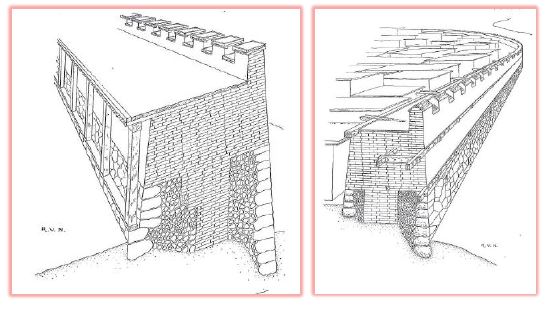
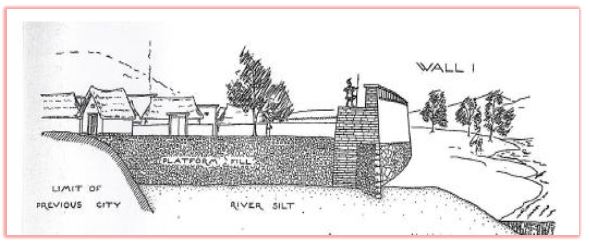
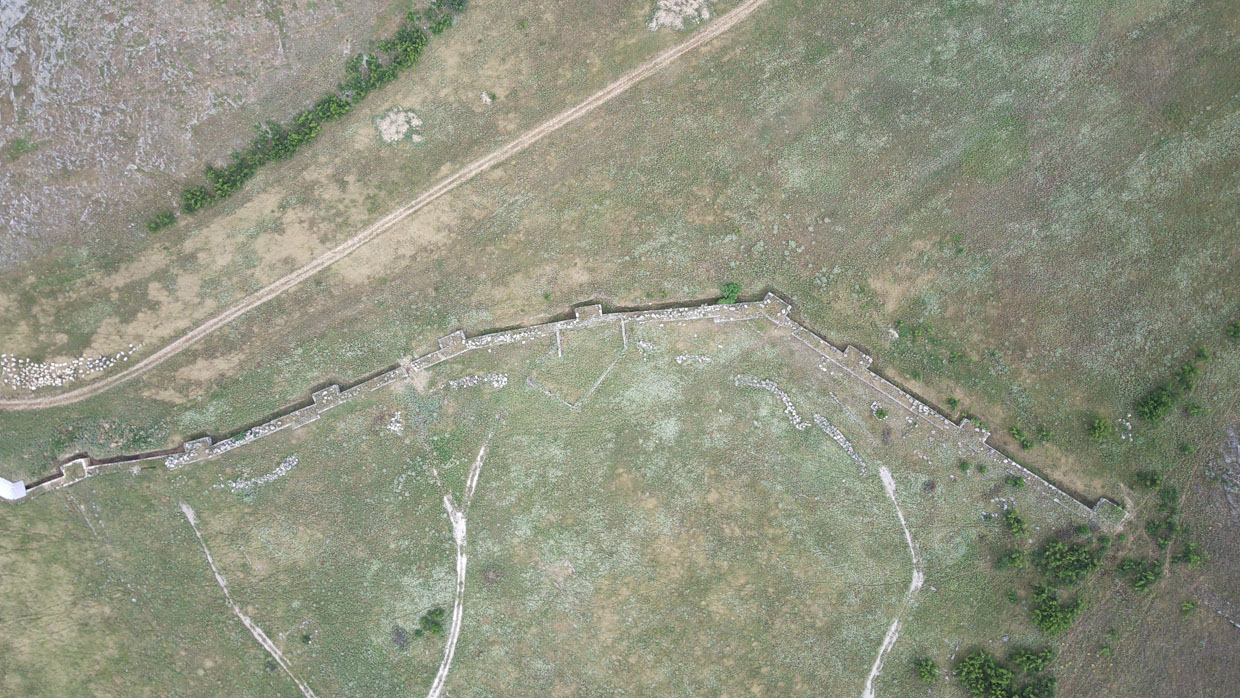
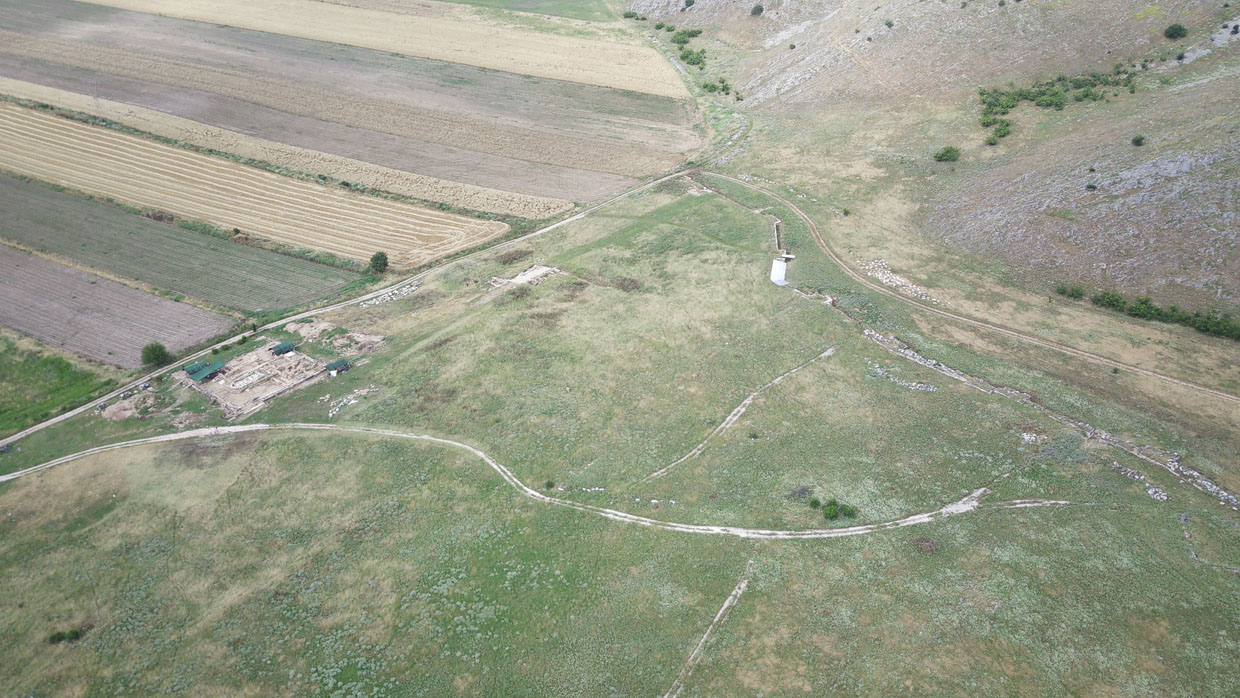
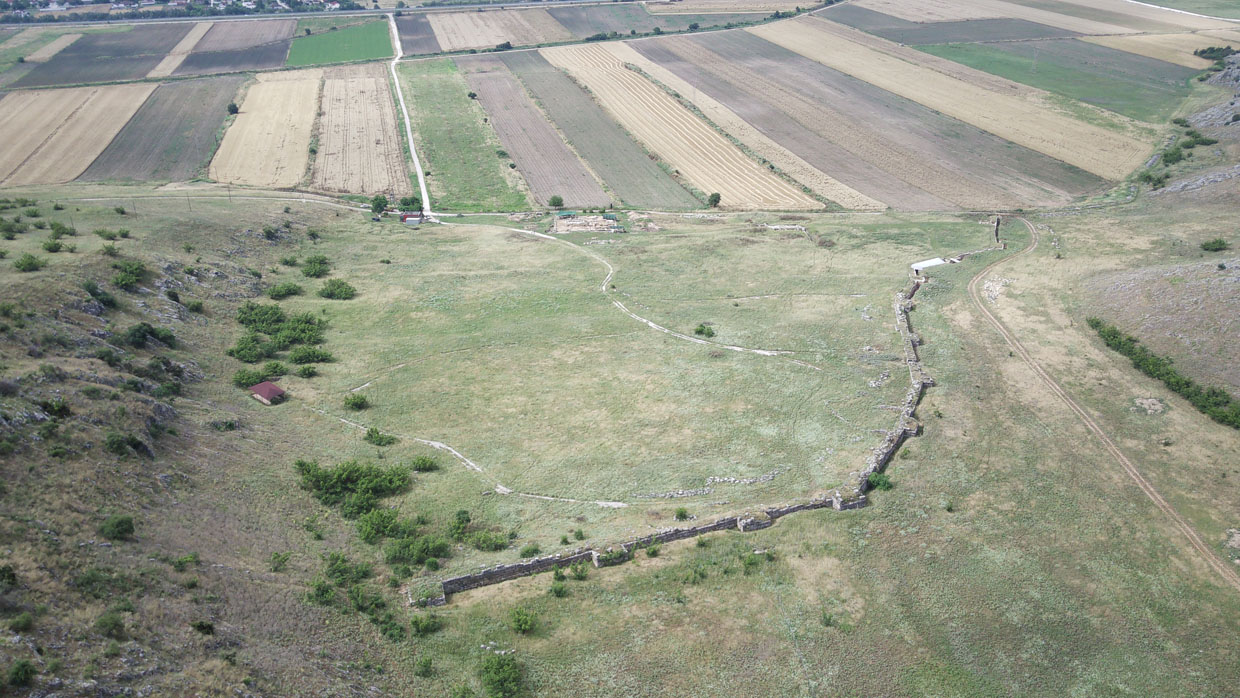
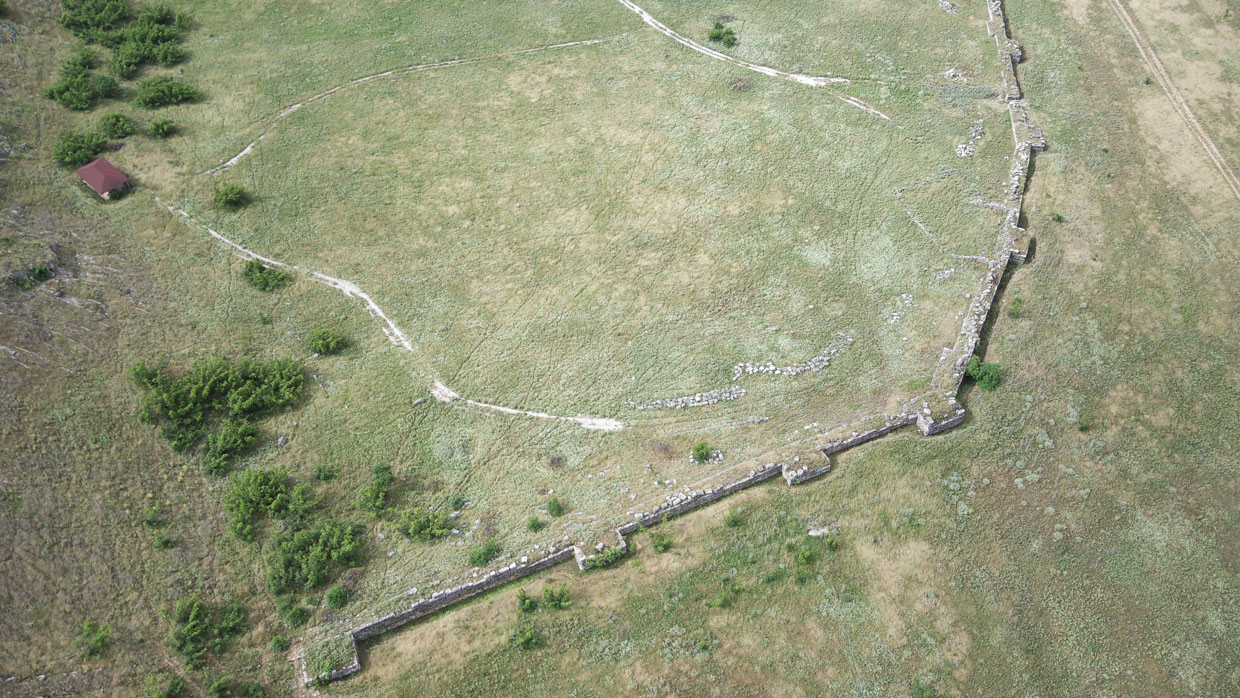
History of the city
Although the exact location of Pelinna was not certified by the excavations, almost all researchers identified the ancient Pelinnaion with the ruins of the low rocky hill in Paleogardiki of Petroporos.
The ruins, the foundations of various buildings, the scattered marble architectural members, the finds of great value, the wall which is visible over a considerable area, the excellent strategic location substantiate the information of ancient sources and certify the presence of a great ancient city.
An inscription found in the area in 1958 adds concrete historical evidence to the identification of the glorious ancient city. This inscription is a court order. The judges who belong to the service of the Macedonian king Philip V, are called to adjudicate the territorial disputes between the public of Farkadonia and two private individuals, one of whom, Eulykos, is a resident of Pelinnas.
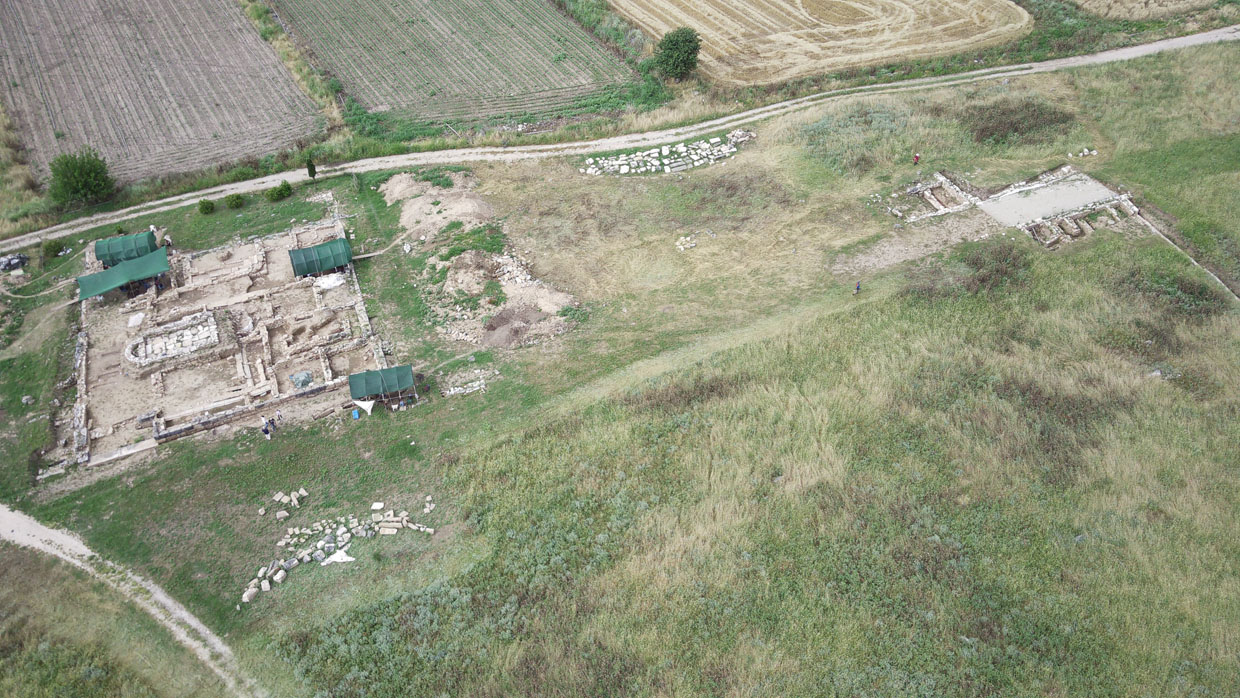
The city during the period of Macedonian rule in Thessaly
According to Fr. Stählin in the 5th century BC Pelinna was a small and organized city, but dependent on Larissa.
In 357 BC came to Thessaly, at the invitation of the Larissaian Aleadians, the king of Macedonia, Philip II, who freed the Thessalian cities from the Ferraraic yoke.
Following a smart policy, Pelinna supported Philip and thus prevailed over its two neighboring cities, Trikkis and Farkadonos, which were captured by the Macedonians in 353 BC. Their walls were destroyed and many of their inhabitants exiled. The estates mainly of Farkadonos but also a large part of the estates of Trikki came to Pelinnaeo, which now occupied a larger area.
The Pelinnaeans in return followed the Macedonians in almost all their operations and maintained their friendship with them. In addition, the Pelinnaeans enjoyed the favor of Philip, but also of Alexander and his successors due to the excellent strategic position that their city had, as it controlled the road axis from Trikki to Larissa and especially the narrow passage between the confluence of the Litheos with the Pinios river and the provounos of the Khasias.
Thus Pelinna soon became a great Macedonian fortress. Philip II allocated a lot of money from his public funds for this purpose. He established a permanent garrison – if not a population, the city extended over a large area of the plain and was fortified with a new strong wall, the northern leg of which was not continuous but interrupted by steep cliffs. In other words, there was a combination of physical and technical fortification.
The new wall gave the city a majestic beauty. It was built according to the principles of the martial art of the late classical period with hewn rectangular stones from local white-brown limestone that came from the ancient quarries of the dolin. The total thickness of the wall was about 2.70-2.80 meters and the final height undetermined, because nowhere was it preserved intact. Stählin had counted a number of towers extending across the city wall and citadel, most of which are no longer visible.
All of them were square except for one on the western wall of the acropolis which was circular and they were 30m apart. There was a fortification ditch, the elements of which have been completely altered, especially after the drainage of the “Voula” marsh. During these years, Pelinna was organized according to the Hippodamian urban planning system and occupied an area of approximately 800 acres.
F. Stählin during his visit to the archaeological site, at the beginning of the 20th century, saw several remains of public buildings, an ancient theater, a temple of the mainly worshiped deity, Athena, and of Zeus the Bringer, public sanctuaries as well as sanctuaries with a rectangular enclosure and a small temple in its center.
The private houses had a stone foundation and a roof made of laconic tiles. In some cases their area reached 200 sq.m. and provided many comforts to their owners. It is not possible to formulate details, especially about the political institutions, because no systematic excavations were carried out in the area and the scientific data is insufficient.
The presence of a hewn well 1.5-2 meters in diameter, of unknown depth, outside the southern leg of the wall and the stone staircase that starts from the western leg of the wall and ends at the northwestern slopes of the hill, mean that the city would have been irrigated by these the years with wells and springs.
From here according to Arrian in 335 BC. Alexander the Great passed and spent the night with his army during his descent towards southernmost Greece against the rebellious Thebans.
Two more facts confirm the strong position of Pelinna. In the years 333-328 BC a Pharsalius and a Pelinnaeus are mentioned together as hieronyms of Thessalians. Also in the years 346-328 BC. some temple builders from Pelinna are known in Delphi. During the period of the Lamian war (323/322 BC), contrary to the rest of the Thessalians, he remained on the side of the Macedonians and in this Antipater waited for the reinforcements of Crateros, when the military operations were transferred to Thessaly.
The strong friendly relations that connected them can also be seen from the famous diagram of the steward of the Macedonian throne, Polyperchon, in 319 BC, with which amnesty was given to the exiled citizens of Thessalian cities and they were allowed to return to their homes. The only ones excluded from the amnesties were the Trikalinoi and Farkadonii. This fact was probably due to the pressure exerted by the Pelinnaeans on the Macedonians so that they would not be forced to return the lands they had encroached upon. «Μὴ κατιέναι μηδὲ Μεγαλοπο-λιτῶν τοὺς μετὰ Πολυαινέτου ἐπὶ προδοσία φεύγοντας μηδ’ Ἀμφισσεῖς μηδὲ Τρικκαίους μηδὲ Φαρκαδονίους μηδ’ Ἡρακλεώτας».
When, after the death of Alexander the Great, the Athenians resolved to throw off the Macedonian yoke, and sent ambassadors to the Greek cities to encourage them to this end, all the Thessalian cities agreed to revolt except Pelinna. «Τῶν δ’ ἄλλων ‘Ελλήνων οἱ μὲν πρὸς Μακεδό-νας ἀπέκλινον, οἱ δὲ τὴν ἡσυχίαν εἵλοντο. Αἰτωλοὶ μὲν οὐν ἅπαντες πρῶτοι συνέθεντο τὴν συμμαχίαν, καθάπερ προείρηται, μετὰ δὲ τούτοις Θετταλοὶ μὲν πάντες πλὴν Πελινναίων».
In 191 BC and for a short time it was occupied by Amynandros of Athamanos, an ally of Antiochus III of Pergamum.
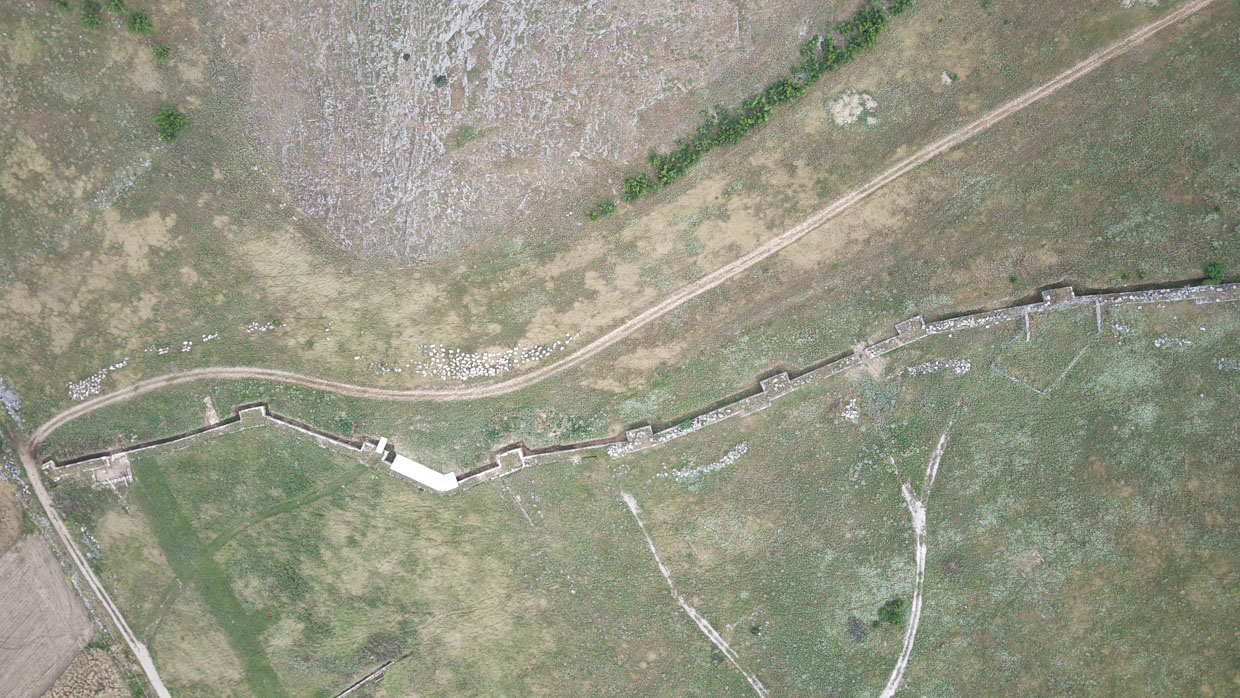
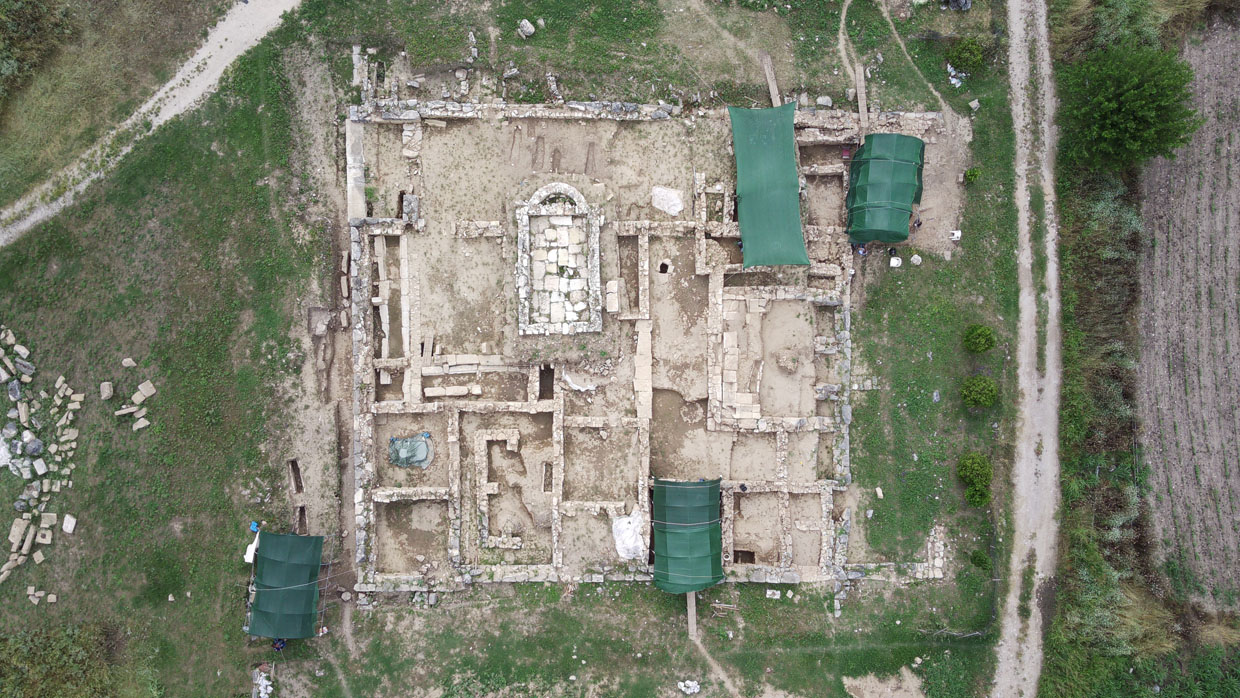
Pelinna in the Roman-Byzantine years
Signs of decline begin to appear from the end of the 2nd century. BC, when it turns into an insignificant polis of the Roman Empire.
In the Byzantine years, the city was significantly reduced and only included the area of the ancient acropolis. The national name Pelinnaevs appears for the last time around 130 BC. when the veterinarian Mitrodoros Andromeneios was honored in a consular resolution of Lamia for his great contribution to their city.
The name Gardiki by which she is known to us goes back to the Old Slavic word meaning polychine, countess. As a bishop’s seat, it is mentioned for the first time in Tactic, at the beginning of the 11th century, belonging to the Metropolis of Larissa, while it is mentioned for the last time in 1371. At the end of the 12th century. AD, from a letter of Michael Choniatis to the bishop of Gardiki, we know that the city was known for its skilled carvers.
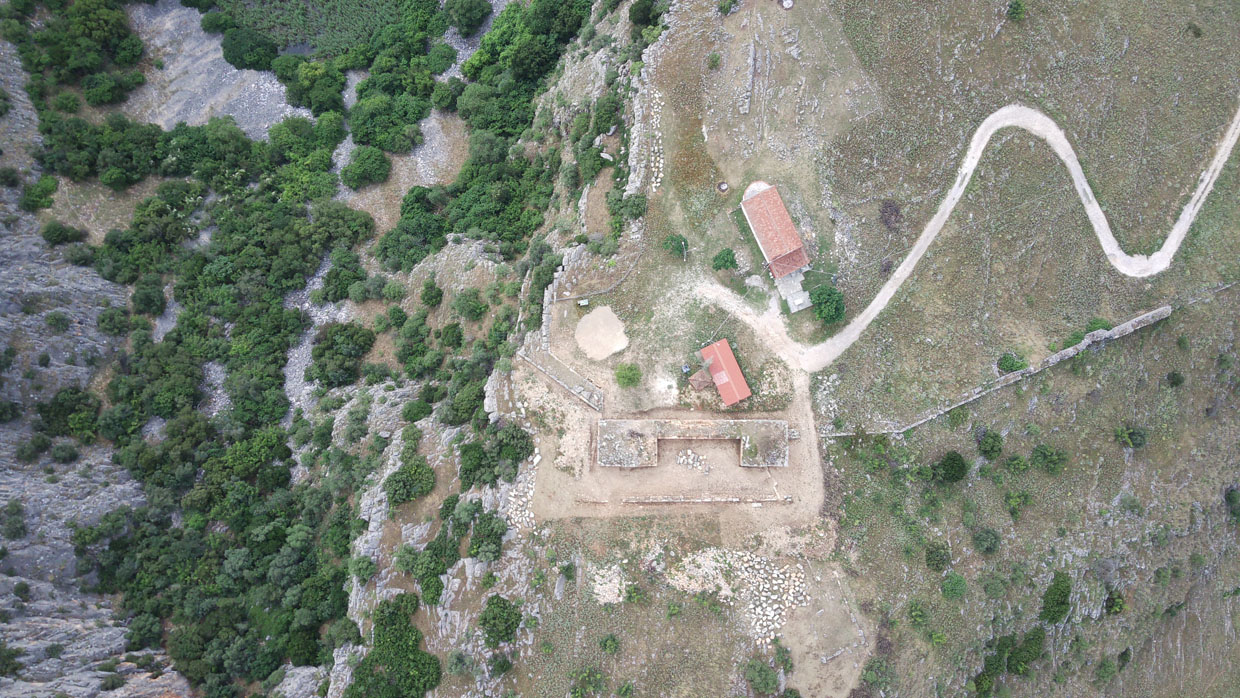



Economic history of the city
The city experienced strong economic growth, mainly during the Macedonian presence in Thessaly. She minted her own coins, silver and bronze. In them are depicted either horsemen or warriors or the goddess Athena – Victory and in some of them Sibylla Manto, daughter of Mantis Teiresias, holding a basket in her hand from which her oracles come out.
SPECIMENS OF PELINNA COINS

Front view
Depicted is a Thessalian horseman wearing petasos and chlamys holding a spear in a transverse position. He leads galloping horse to right. Below, in small letters, IA. The inscription seen in small letters on the coin probably represents a sign of the control of the officials who were responsible for minting the coin.
Reverse
Depicted warrior advancing (advancing) left, wearing petasos and chlamys. He has a sword in a scabbard hanging from a diagonal belt. With his right hand he throws a short spear while in his left he holds a round shield, decorated with a star, and two other spears. There is the inscription PEL – IN. Its features are beautifully accentuated and an extremely fine cut on the edge of the coin (at 45° clockwise where the 1 hour is marked) can also be seen.
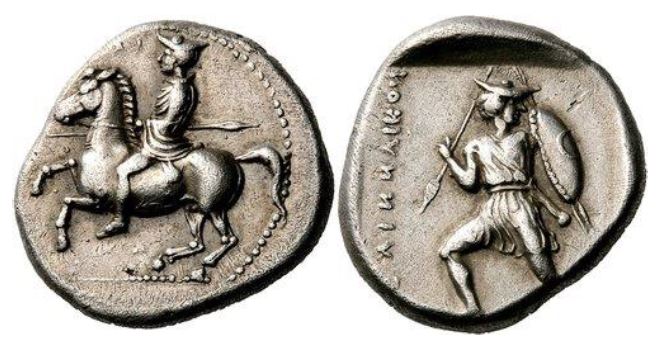
The obverse depicts a Thessalian horseman wearing petasos and chlamys. In his right hand he holds a spear pointing backwards. He is moving left on a galloping horse. On the upper left there is an engraved inscription AI in small letters.
The reverse depicts a warrior advancing to the left with his head turned to the right. He wears a petazzo and chlamys and has a sword hanging from a diagonal belt in a scabbard with a spherical tip. He holds a short spear in his right hand while in his left he holds a round shield, decorated with a crescent moon, and two other spears. There is still the inscription [Π]HELLINNAICON with inverted Ns.
Although the coin has a few small marks and the surface is slightly rough, it is a clear and extremely fine build. Very rare, kept in excellent condition. The inscription seen in small letters on the coin probably represents a sign of the control of the officials who were responsible for minting the coin.
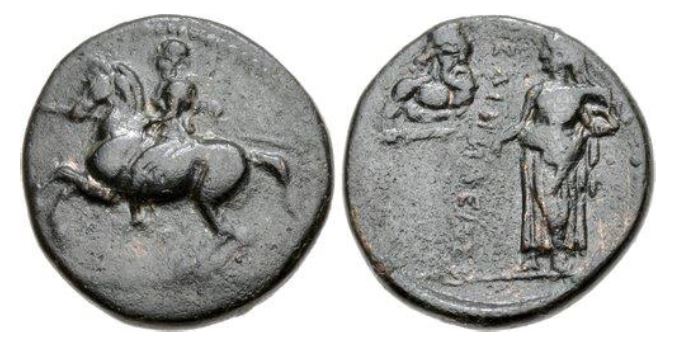
The obverse depicts a Thessalian horseman with helmet and breastplate. He wears a short tunic and a robe (chitona). Ephora holding outstretched lance astride galloping horse left. Above his head is a border of dots.
On the reverse on the right, Manto is depicted with her head covered and a robe (shawl) thrown over her shoulders. She stands with the body before her and her head turned up and to the left looking towards her father Teiresias. In her left hand she holds an open box while with her right hand she points down.
Opposite her is Teiresias in half-length as he is depicted emerging from the Underworld holding a knife in his right hand. Between them and in a diagonal position from top to bottom is the inscription [Π]ΕΛΙΙΙΑΕΙΟΙΙ (with inverted N). This is a fascinating coin in fairly good condition that imaginatively depicts the legend of the seer Tiresias. It is perhaps the best known of the few in existence and the only one kept in a private collection.
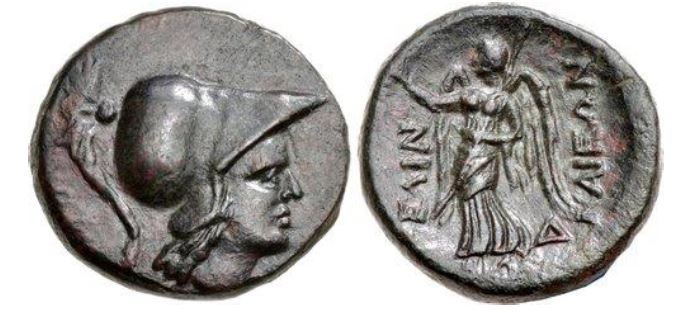
The obverse depicts a head of Athena facing right while wearing a Corinthian helmet.
The reverse depicts the winged Goddess Nike with her head covered by a veil that falls over her left shoulder. In her outstretched right hand she holds a wreath. With her left hand she holds a spear resting on her left shoulder. There is the superimposition [Π] ΕΛΙΝ – NAIEΕΟN running from bottom to top on both sides of Victory.
x The reverse depicts the winged Goddess Nike with her head covered by a veil that falls over her left shoulder. In her outstretched right hand she holds a wreath. With her left hand she holds a spear resting on her left shoulder. There is the superimposition [P] ELIN – NAIEEON running from bottom to top on both sides of Victory.

The obverse depicts a horseman wearing a helmet, breastplate and waving tunic. Moves to the right with spear raised to strike an invisible opponent. All within a border of dots, just off the center of the coin.
The reverse depicts a warrior, dressed in a short tunic. In his left hand he carries a shield while in his right he holds a raised spear poised to strike an invisible opponent. There is the inscription PELINN – AIKON in a clockwise direction on either side of the warrior. All within a shallow concave square. Dark brown patina with some small areas of dark red. In a very good condition.
Archaeological findings
In recent years, on the occasion of water supply and road construction projects, tombs (box-shaped, pit-shaped, tile-roofed, cases, clay and stone urns) have been excavated, covering the period from the 5th to the 2nd century. e.g. as well as a vaulted roof from the Hellenistic Era, which was covered by a mound.
Most of the archaeological finds are from the cemetery and, among other things, reveal that Pelinna was a very important center of Dionysian worship and the performance of Bacchic and Orphic mysteries.

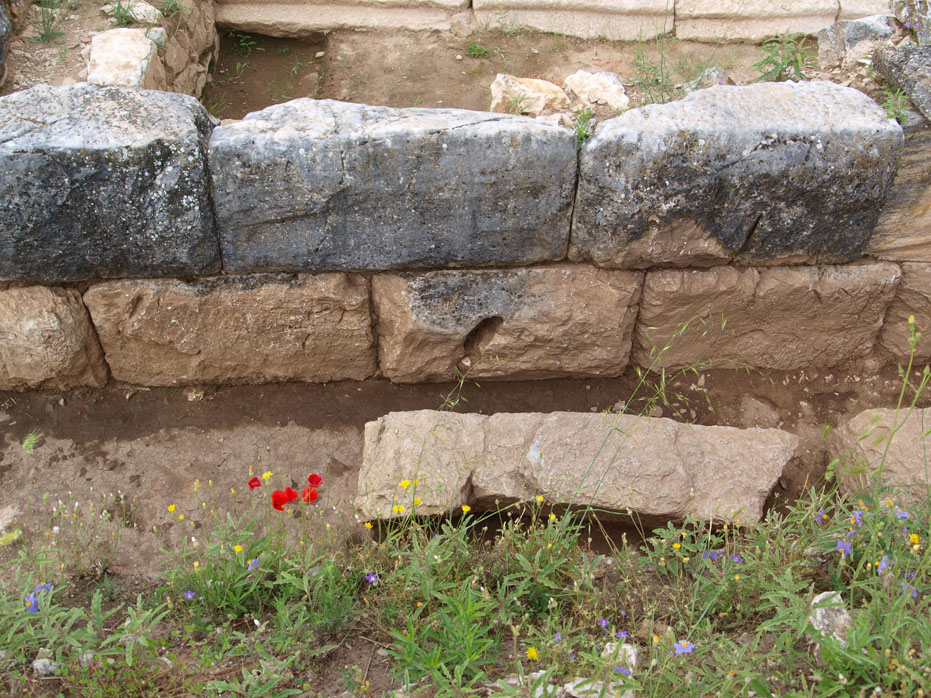
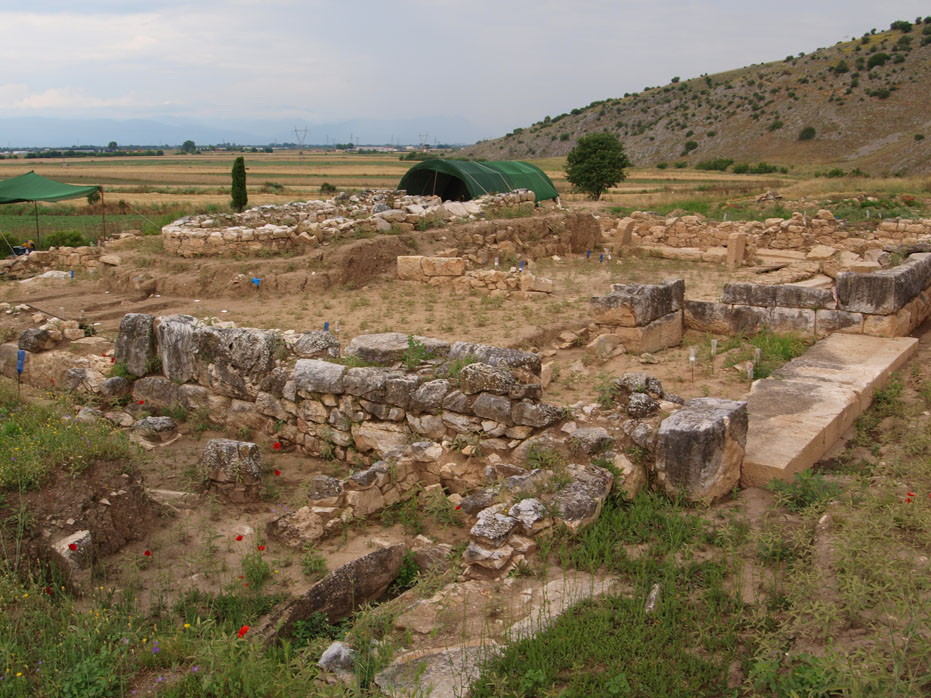

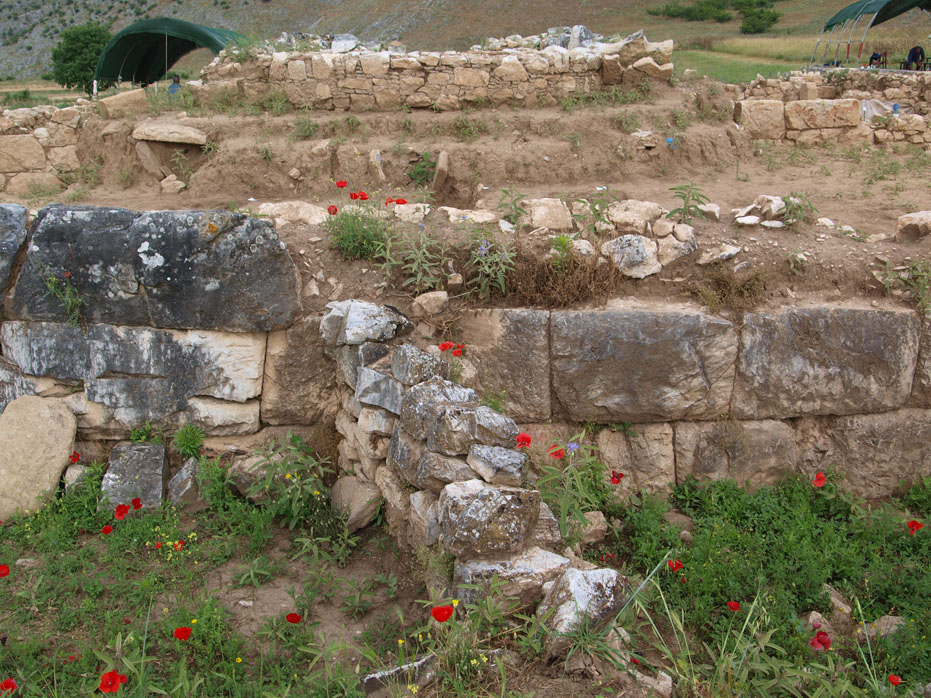
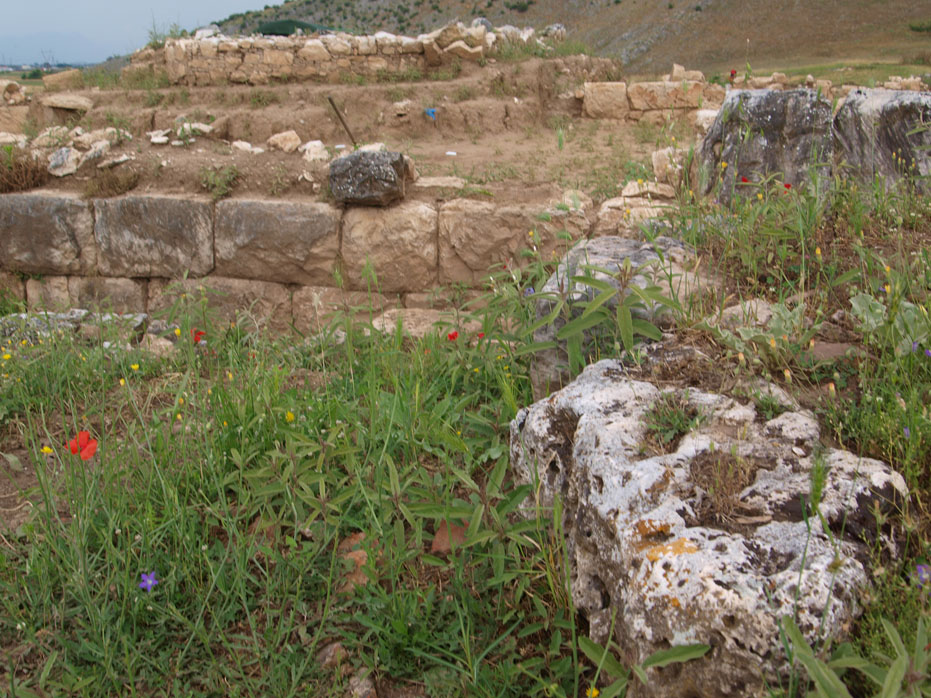
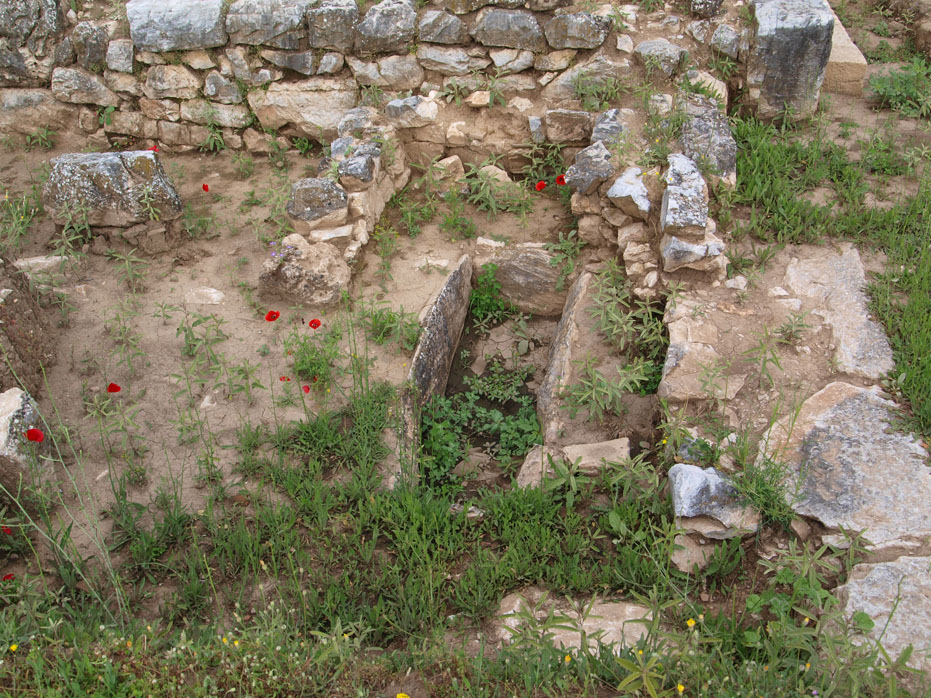
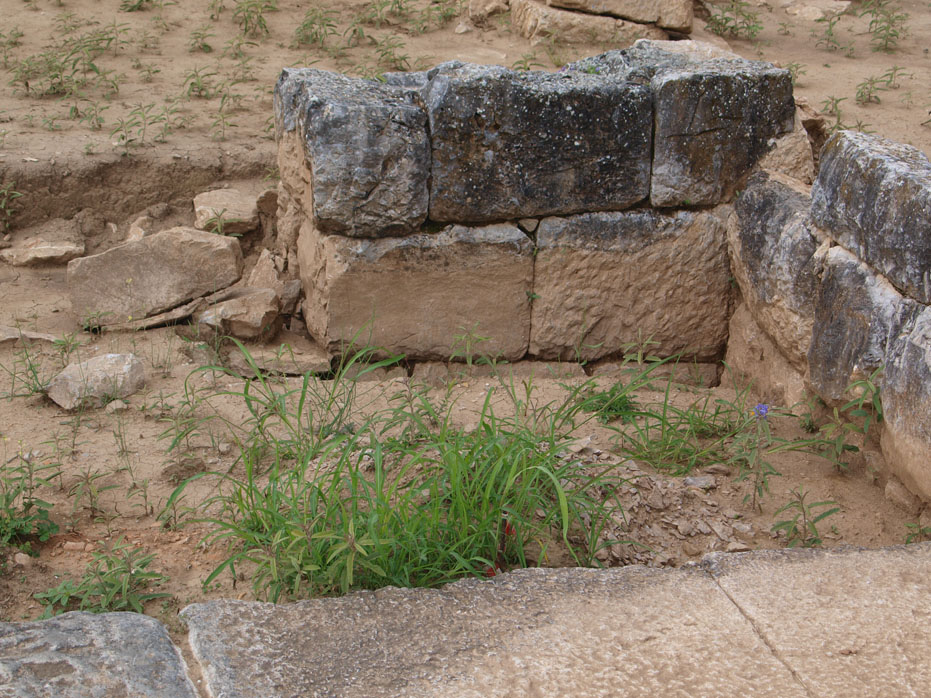

Among the oldest findings, the following stand out:
✓ Bronze hydria of the 6th BC h. which was found in a tomb in 1937 and is considered the work of a Corinthian workshop. (National Archaeological Museum).
✓ Tombstone of the 4th BC h. of white marble. On the main face it has a relief representation of a young man on horseback (Louvre Museum).
✓ Sepulchral stele of the 3rd BC h. of grey-white marble with a relief hymn and two-line inscription “Cleopatra – Kylanou”.
✓ Sepulchral stele of the 3rd BC h. with the inscription “Kleinippos ‘Onassies”.
✓ Temple-shaped votive column of the 3rd BC. h. with incomplete inscription.
✓ Sepulchral stele of the 2nd BC h. with relief representations of male and child figures.
✓ Votive column of the 1st BC h. on the upper part of which there is the inscription “Dii Kataivati”.

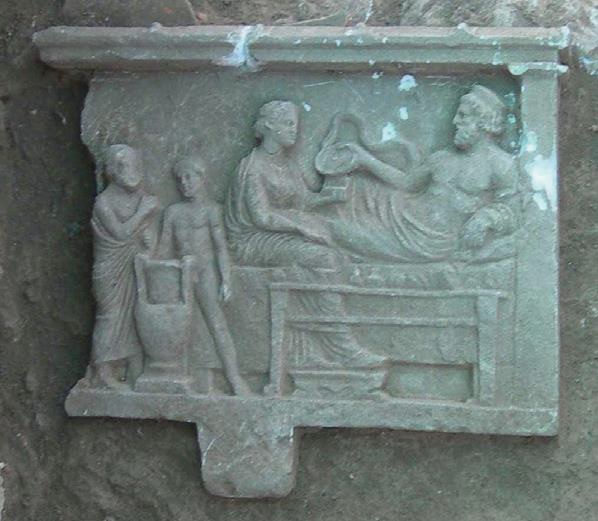
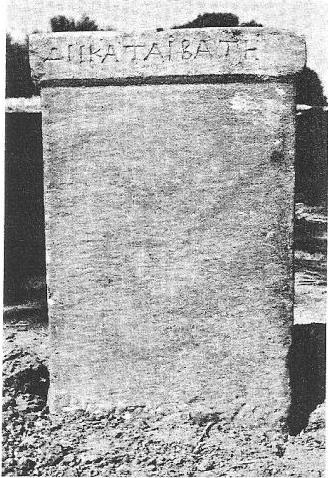
Archaeological Collection of Trikala
Description: votive column of white marble. It bears an epitaph, where there is the inscription:
Διί Καταιβάτῃ
The stele was probably decorated with a written representation, of which no traces can be discerned.
Dimensions: height: 0.56 m, width: 0.32 m
Dating: 3rd 2nd c. e.g.
Provenance: delivered to the Trikala Archaeological Collection together with two other columns by a farmer. They are the first columns that came from the ancient Pelinna or Pelinnaion
The ancient Pelinna is identified with the findings of the year 1969 in two box-shaped tombs of gold gifts from 200 – 150 BC. The treasure consists of:
A pair of Hellenistic fine gold rings in the shape of a diphrus (two-horse chariot).
✓ Gold bracelet in the shape of intertwined snakes
✓ Gold ring with precious stones on both the sling and the bezel
✓ Gold necklace with a chain on which hang a) relief figures of people, b) various eros with their quivers and c) eagles
✓ Two golden wreaths with olive and oak leaves
